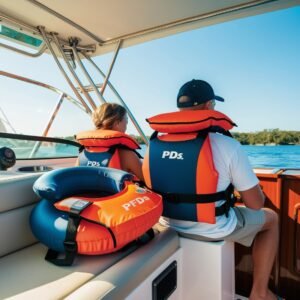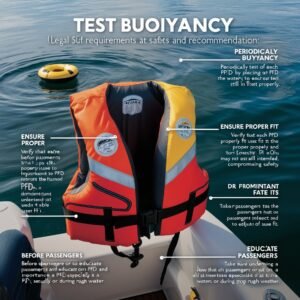
Where is the best place to put a PFD when you are on a boat?
When traveling on a boat, ensuring the safety of all passengers is paramount. Of the essential safety equipment on any boat, personal flotation devices (PFDs) are non-negotiable. Proper storage and easy access to PFDs can mean the difference between life and death in an emergency. This comprehensive guide will explore the best practices for placing PFDs on a boat and ensuring they are accessible and functional when needed most.

Why PFDs are important
PFDs, commonly known as life jackets, are designed to keep people afloat in water, reducing the risk of drowning. Their importance cannot be overstated, as they are essential life-saving equipment in the event of a boating accident, unexpected drowning, or overboard situation.
Wearing a PFD increases the chances of survival by keeping the person’s head above water and reduces the risk of hypothermia by keeping the body insulated. For these reasons, it is very important to have enough PFDs on board for each passenger, and they should be easily accessible.
Best Practices for PFD Placement
Keep PFDs Visible and Unobstructed Store PFDs in an open, visible area where they are not blocked by other equipment or gear. This makes it easy for passengers to quickly grab other items without having to find them or move them out of the way.
Avoid Locked Compartments Do not store PFDs in locked compartments or storage areas that require keys or tools to access. In an emergency, passengers may not have the time or means to open such boxes.
Use Dedicated PFD Storage Racks If available, use dedicated storage racks or holders designed specifically for PFDs. These racks keep PFDs organized and prevent them from being misplaced or forgotten.
Strategic Placement While Sailing
Strategically placing PFDs throughout the boat ensures that wherever the passenger is, the PFD is always close at hand. Consider the following placement strategies:
Near the helm and cabin Place PFDs near the helm and the main cabin of the boat where passengers often congregate. This ensures that the boat operator and passengers can easily access the PFD when needed.
Near Seating Areas Ensure that PFDs are accessible from all seating areas, including bow and stern seats. This placement allows passengers to quickly access the PFD without moving away from their seats.
In water sports zones If your boat is used for water sports, such as water skiing or tubing, place PFDs in the designated area where participants prepare for their activities.
The most important aspect of PFD placement is accessibility. In an emergency, every second counts, and passengers need to be able to access the PFD quickly and easily. Here are some tips to make sure PFDs are always within reach:

Regular Inspection and Maintenance
To ensure that PFDs are in good working condition, perform regular inspections and maintenance:
Check for damage Inspect PFDs for any signs of wear and tear, including rips, tears, or damage to straps and buckles. Replace any PFDs that are damaged or no longer safe.
Test Buoyancy Periodically tests the buoyancy of each PFD by placing it in the water to ensure it still floats properly.
Ensure proper fit Verify that each PFD properly fits its intended user. PFDs that are too large or too small may not function as intended, compromising safety.
Educate Passengers
Before departure, take a few moments to educate passengers on the proper use and importance of wearing a PFD. Demonstrate how to put on and adjust a PFD for a secure and comfortable fit. Make sure passengers understand the importance of wearing a PFD at all times, especially in rough waters or during rough weather.
Legal Requirements and Recommendations
Familiarize yourself with local and federal regulations regarding PFDs. For example, the US Coast Guard requires that all boats have a PFD for each person. Additionally, children under a certain age must wear a PFD at all times when the boat is in motion.
Beyond Minimum Requirements
While it’s important to follow legal requirements, consider going beyond the minimum. Keep extra PFDs on board in case of unexpected passengers or emergencies. Equip your boat with a variety of PFDs, such as disposable flotation devices and inflatable PFDs, to increase safety and compliance.
Finally, the best place to keep PFDs on the boat is where they are most accessible and visible to all passengers. By strategically placing PFDs

1 Why is it important to store PFDs in an easily accessible location on a boat?
Storing PFDs in an easily accessible location ensures that passengers can quickly and efficiently grab them in an emergency. Time is crucial in such situations, and having PFDs within arm’s reach can significantly reduce response time, potentially saving lives.
2 Where should PFDs not be stored on a boat?
PFDs should not be stored in locked compartments, under heavy gear, or in areas that are difficult to reach. Storing them in such places can delay access during emergencies and increase the risk of accidents due to the time taken to retrieve them.
3 What are the benefits of using dedicated PFD storage racks on a boat?
Dedicated PFD storage racks keep life jackets organized and in a consistent location, making them easy to locate and access quickly. They also help prevent PFDs from becoming tangled or misplaced, ensuring they are ready for immediate use.
4 How can the strategic placement of PFDs enhance safety on a boat?
Placing PFDs near the helm, seating areas, and activity zones like water sports preparation areas ensures that everyone on board has a PFD within easy reach. This distribution reduces the time needed to equip a life jacket in case of an emergency, enhancing overall safety.
